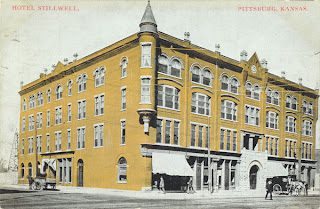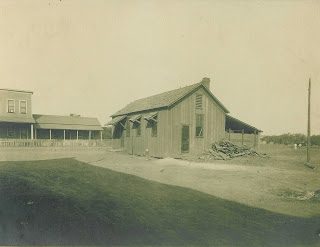I Owe My Soul to the Company Store

By Mary Adams
Thurber, Texas, located approximately 70 miles west of Fort Worth, was a self-sufficient town in many aspects thanks in part to the Texas Pacific Mercantile and Manufacturing Company, a subsidiary of Texas and Pacific Coal Company. TPM & M provided for the material needs and desires of the residents by carrying a wide range of products in its numerous subsidiaries which included a meat market, dry-goods and general merchandise, as well as the drug and hardware stores.

The stores located in the town, the only source of goods in Thurber, served the households of miners, company officials, and farmers in the surrounding area. A careful examination of the following photo taken inside the hardware store prior to 1913, reveals the variety of products offered to suit the diverse tastes and budgets of its customers.

The left side of the store is dedicated to household goods and furnishings. The case in the lower left side of the photograph contains boxes of knives and eating utensils (1). The boxes in the case identify one of the suppliers for the store, the catalog firm, E. C. Simmons Cutlery and Hardware Company. The shelves behind the counter displays a mixture of items (2) including stacks dinner plates, cups and bowls, sugar bowls, crystal bowls and glass pitchers, and a variety of enamel cookware (4). Kerosene lamps as well as replacement shades sit above the dishes (3). Can you pick out other household items such as roaster pans, chamber pots, and aluminum tubs on display?
The store carried a large selection of heaters and cook stoves in several styles. Note the differences between the multiple models that appeal to various needs and tastes. In 1910 heaters like the one tucked beside the cabinet next to the row of wood burning stoves sold for approximately $4.95 (5) while others such as the plain version sitting towards the rear of the store went for $1.69 (10). They also provided multiple options in cooking ranges which included different sizes and attachments such as a warming oven (6).
The loft (8) at the back of the building holds a selection of furniture such as chairs, tables or desks, and a stack of mail boxes. Behind the stoves and heaters along the back and right of the store there is a shelf of tin goods including milk strainers, stock pots (12), shallow tubs, and coffeepots (13). Also notice the row of “Kant Leak Oil Cans” used to store the kerosene used to fuel portable and permanent fixtures like those hanging from the ceiling above the case on the right (11).
The hardware store met the work needs of both the company and its employees by keeping basic supplies like screws, nails, and small hand tools. Because the coal miners supplied their own equipment the inventory included shovels, tool handles and blasting powder. It also ordered equipment requisitioned by departments within the company. As a result, the shelving on the right side of the photograph displays some tools and other hardware. You can search for items such as a box of Blue Jay oilers (14), stacks of Disston hand saws (15), wood planes, and along the right edge of the photo multiple boxes of ammunition (16).

Residents in need of carriages and animal tack found their way to the hardware store as well. The photograph captured two buggies, one on the left side at the rear of the building (7) as well as one under the loft. They supplied harnesses, sundry other horse tack (hanging on the back wall, under the loft), and horse collars hung from the ceiling in front of the loft (9).
As this photograph indicates the hardware department of the TPM & M carried a variety of essential items which meant that almost any item could be bought locally. This allowed the parent company, Texas and Pacific Coal Company, to increase their profits by keeping their money centralized. Items not found in this photograph, such as clothing, food products, or jewelry could be purchased at other locations in town.





